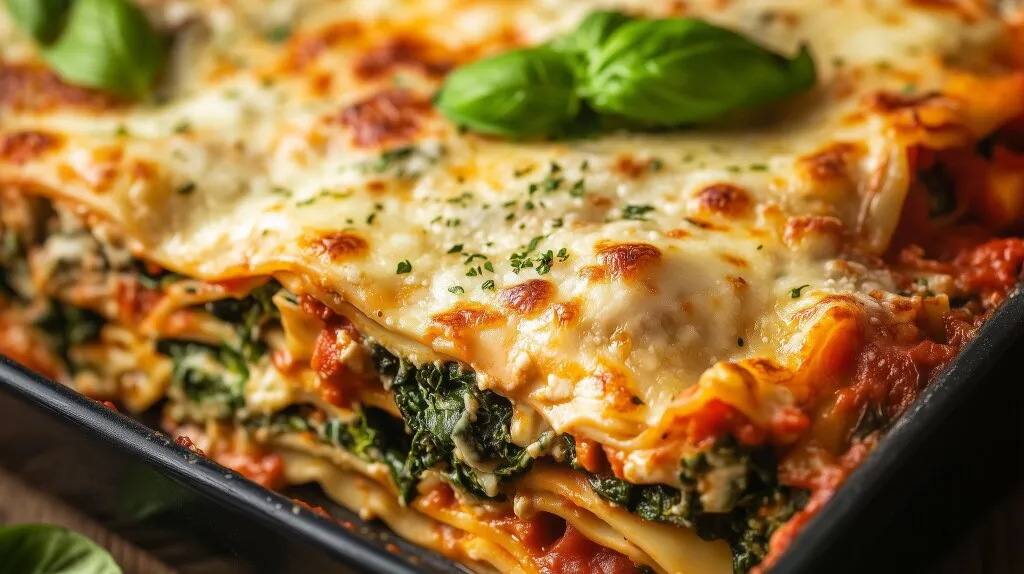The Best Fluffy Pancakes recipe you will fall in love with. Full of tips and tricks to help you make the best pancakes.
Looking for a hearty, comforting dish that skips the meat but keeps all the flavor? This vegetarian lasagna recipe is exactly what you need. Packed with layers of tender lasagna noodles, rich tomato sauce, perfectly sautéed vegetables, and a creamy blend of ricotta, mozzarella, and parmesan, it’s a meatless lasagna that even carnivores will crave. Whether you’re trying to eat more plant-based meals or just love a great vegetable pasta bake, this dish delivers all the comfort of traditional lasagna—without the beef. Plus, it’s easy to make, meal-prep friendly, and perfect for weeknight dinners or special occasions alike.
Why You’ll Love This Vegetarian Lasagna
If you think lasagna needs meat to be satisfying, this recipe will prove you wrong. This vegetarian lasagna is rich, hearty, and bursting with layers of flavor and texture that make it just as indulgent as the traditional version.

1. Hearty and Filling Without the Meat
Thanks to layers of cheesy ricotta, savory vegetables, and perfectly seasoned marinara sauce, this dish feels like comfort food at its finest. Ingredients like mushrooms, zucchini, and spinach add depth and a meaty texture that satisfies even the biggest appetites—no ground beef or sausage required.
2. A Great Way to Eat More Vegetables
This recipe is packed with nutrient-rich vegetables like spinach, bell peppers, mushrooms, and eggplant. It’s an easy and delicious way to sneak more plant-based goodness into your meals—especially for picky eaters or kids.
3. Perfect for All Occasions
Whether you’re feeding your family on a busy weeknight, making something impressive for a dinner party, or prepping freezer meals, this lasagna fits the bill. It’s make-ahead friendly, easy to portion, and even better the next day.
4. Customizable and Diet-Friendly
Gluten-free? Swap in gluten-free noodles. Avoiding dairy? Try plant-based cheeses. Want to add extra protein? Toss in lentils or tofu. This dish is highly adaptable to meet different dietary needs without compromising flavor.
Key Ingredients for a Flavorful Vegetarian Lasagna
The secret to an unforgettable vegetarian lasagna lies in using fresh, high-quality ingredients that bring richness, depth, and balance to every bite. Each layer plays an important role, from the pasta and sauce to the vegetables and cheese. Here’s a closer look at the essential components that make this dish truly satisfying:
1. Lasagna Noodles
You can use classic lasagna noodles, no-boil sheets, or even gluten-free pasta, depending on your preferences. No-boil noodles are especially convenient and save time, but make sure your sauce has enough moisture to soften them while baking. For added nutrition, try whole wheat noodles for extra fiber.
2. Cheese Blend
Cheese is what makes lasagna irresistibly creamy and indulgent. This recipe typically includes:
- Ricotta cheese: Light, fluffy, and perfect for layering. You can mix it with an egg and herbs for added flavor.
- Mozzarella cheese: Adds that stretchy, gooey texture on top and between layers.
- Parmesan cheese: Sharp and salty, it’s ideal for sprinkling over the final layer to get a golden, crispy finish.
For a vegan version, swap in plant-based cheese alternatives like almond ricotta or dairy-free mozzarella shreds.
3. Vegetables
The veggies are the heart of this dish. Use a mix of tender and hearty options for contrast in flavor and texture:
- Spinach (fresh or frozen): Wilts beautifully and blends well with the cheese layer.
- Zucchini and Eggplant: Thinly sliced, roasted, or sautéed for a meaty bite.
- Mushrooms: Add umami depth and richness, especially when browned properly.
- Bell Peppers or Onions: Bring sweetness and balance to the acidity of the tomato sauce.
Feel free to roast or sauté your vegetables beforehand to intensify their flavors and prevent excess moisture.
4. Tomato Sauce
A flavorful marinara sauce is essential. You can make your own with crushed tomatoes, garlic, onion, and Italian herbs, or use your favorite store-bought variety. For extra flavor, simmer it with basil, red pepper flakes, and a splash of olive oil.
5. Herbs and Seasonings
Italian seasoning, fresh basil, garlic, black pepper, and salt are key to enhancing all the layers. Don’t skip the fresh parsley or basil garnish—it adds brightness and freshness to every bite.
Step-by-Step Instructions to Build the Perfect Lasagna
Making a flavorful, satisfying vegetarian lasagna is easier than you think—just follow this step-by-step process. With a little prep and layering, you’ll create a dish that’s both beautiful and delicious. Here’s how to do it:
Step 1: Prepare the Vegetables
Start by washing and chopping your veggies.
- Sauté mushrooms, zucchini, and bell peppers in olive oil with garlic and onion until soft and slightly caramelized.
- If using spinach, cook until just wilted (or thaw and squeeze if using frozen).
- Tip: Pre-cooking your vegetables helps remove moisture and prevents a watery lasagna.
Step 2: Make the Ricotta Filling
In a medium bowl, mix:
- Ricotta cheese (about 2 cups)
- 1 egg (for binding)
- ½ cup grated parmesan
- Salt, pepper, and a pinch of nutmeg or Italian seasoning
- Optional: Add a handful of chopped fresh parsley or basil for extra flavor.
This mixture will add creaminess and structure to the layers.
Step 3: Get the Sauce Ready
Use a flavorful marinara sauce—either homemade or a good-quality jarred option. You’ll need about 3 to 4 cups.
- If using homemade, simmer crushed tomatoes with garlic, olive oil, and herbs until thickened.
- Want extra depth? Add a splash of red wine, or stir in some chili flakes for a kick.
Step 4: Layer the Lasagna
Time to build! In a 9×13 inch baking dish, follow this order:
- Spoon a thin layer of tomato sauce on the bottom.
- Add your first layer of lasagna noodles (cooked or no-boil).
- Spread some ricotta mixture over the noodles.
- Top with sautéed vegetables.
- Add more sauce and a handful of shredded mozzarella.
- Repeat the layers 2–3 times, ending with sauce and a generous layer of mozzarella and parmesan on top.
Step 5: Bake to Golden Perfection
- Cover the dish with foil and bake at 375°F (190°C) for 30–35 minutes.
- Remove the foil and bake for another 10–15 minutes until the top is bubbling and golden.
- Let it rest for 10–15 minutes before slicing—this helps the layers set and makes serving easier.
Tips for the Best Texture and Flavor
Creating a truly delicious vegetarian lasagna is all about balance—between creamy and hearty, saucy and structured, fresh and savory. These expert tips will help you elevate your lasagna from good to unforgettable, ensuring every bite is packed with flavor and perfect texture.
1. Sauté or Roast Vegetables Before Layering
Raw vegetables release water as they bake, which can result in a soggy lasagna.
- Sautéing mushrooms, zucchini, spinach, or bell peppers concentrates their flavors and reduces moisture.
- Alternatively, roast them with olive oil, salt, and pepper to bring out their natural sweetness and add a slightly smoky flavor.
2. Use a Thick, Well-Seasoned Sauce
A watery sauce will create a runny lasagna. Choose a rich marinara or tomato basil sauce with enough body to hold its layers.
- Simmer your sauce for 15–20 minutes to let it reduce.
- Add garlic, onion, oregano, and basil to boost the flavor, especially if using a store-bought version.
- Want extra umami? Stir in a teaspoon of soy sauce or tomato paste.
3. Balance the Cheeses
- Use whole milk ricotta for a creamy base that isn’t too watery.
- Mozzarella adds that irresistible melt—use freshly grated if possible for better texture.
- Parmesan brings sharp, salty notes that round out the richness of the dish.
- Don’t overload the cheese—too much can make it greasy and overpower the vegetables.
4. Rest Before Slicing
This is one of the most overlooked but important tips.
After baking, let your lasagna rest for 10 to 15 minutes before cutting into it. This allows the layers to set, preventing it from falling apart and helping the flavors meld.
5. Add Fresh Herbs at the End
Sprinkling fresh basil or chopped parsley over the top just before serving adds a burst of freshness that brightens the entire dish. It also brings visual appeal with a pop of green against the golden cheese.
Serving Suggestions and Storage Tips
This vegetarian lasagna isn’t just a delicious main course—it’s also incredibly versatile when it comes to sides, storage, and meal planning. Whether you’re enjoying it straight out of the oven or saving some for later, here’s how to make the most of every serving.
Serving Suggestions: What to Pair with Vegetarian Lasagna
Pairing your lasagna with the right side dishes helps create a balanced and satisfying meal.
- Fresh Green Salad: A simple mixed greens salad with a light vinaigrette balances the richness of the lasagna. Try adding cherry tomatoes, cucumbers, and red onions for a crisp contrast.
- Garlic Bread or Focaccia: Serve with warm, buttery garlic bread or slices of focaccia to soak up any leftover marinara sauce.
- Roasted or Steamed Vegetables: Try broccoli, asparagus, or carrots tossed in olive oil and herbs for a healthy, vibrant side.
- Soup Starter: Begin your meal with a light vegetable or tomato basil soup to keep the Italian-inspired theme going.
How to Store Leftover Lasagna
This dish stores beautifully, making it perfect for leftovers or weekly meal prep.
- Refrigerator: Store leftovers in an airtight container or cover the baking dish with foil. Lasagna keeps well in the fridge for up to 4 days.
- Freezer: For longer storage, wrap individual portions tightly in foil or place them in freezer-safe containers. You can freeze cooked lasagna for up to 3 months.
Pro Tip: If freezing a whole tray before baking, assemble it fully and wrap tightly in two layers of foil. Label it with the date and baking instructions.
Best Ways to Reheat Vegetarian Lasagna
Preserve flavor and texture with the right reheating method.
- Oven (Best method): Preheat to 350°F (175°C). Cover the lasagna with foil and bake for 20–25 minutes until heated through. Remove foil for the last 5 minutes for a crispy top.
- Microwave (Quick option): Place a slice on a microwave-safe plate. Cover loosely with a damp paper towel to keep it moist and heat for 2–3 minutes, checking halfway through.
- From frozen: Bake covered at 375°F (190°C) for 60–75 minutes, or until hot in the center. Remove foil for the last 10–15 minutes to brown the top.





